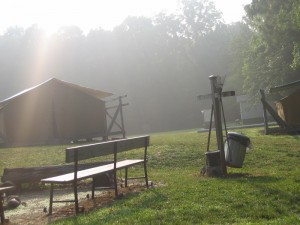How to Keep your Tent Dry
 Does your tent leak? IT SHOULDN’T! I was just reading on some tent manufacturers Facebook pages of customer’s constant complaints about getting water inside their tents. This seems to be a common happening to car campers. Let’s see if we can keep everyone dry.
Does your tent leak? IT SHOULDN’T! I was just reading on some tent manufacturers Facebook pages of customer’s constant complaints about getting water inside their tents. This seems to be a common happening to car campers. Let’s see if we can keep everyone dry.
Keeping Your Tent Dry:
How a Tent is Made
If you have ever sewn, and if you haven’t listen close, you know that you start with a pattern. Sections of material are sewn together to make a larger section, then that section is sewn together to make another section and so on. Then there are holes in the sections, these are the windows, vents and doors. Those are then sewn together with other materials, mesh. The mesh and the tent material are then sewn together with a zipper. By now I hope you are getting the picture. Some of the seams that were sewn together are then covered with heated adhesive tape. All seams are not necessarily taped. It is usually the floor seams and the rainfly. Heat taping is to help stop the seepage of water if it rains on the tent. I am sure you are now asking, how water gets inside if there is tape on the seams?
Seams Silly
That is actually easy to answer. Water will take the path of least resistance. Tent fabric is sewn with needle and thread. That leaves tiny holes in the tent fabric. If you ever have run your hand over a sewn seam of any kind you will notice it is not a perfectly flat surface due to the thread that lay on top of the fabric between the needle holes. Tape does not stick well to bumpy surfaces does it. Heating the tape is kind of like shrink wrapping it. So heating helps but, many times there are spots that the tape may have a gap in it, or the adhesive doesn’t stick. When water finds that gap it then finds the needle holes and leaks in your tent. So how do you stop it from happening?
If you like to sleep in a wet sleeping bag, or like waking up to a wet dog in the tent or pools of water on the floor of your tent, do nothing because you believe that when the box the tent comes in says heat taped, or sealed seams you think… WATERPROOF! Let’s go camping!
Tent Seam Sealer
However if being wet does not appeal to you, this is what you should do. When you purchase your tent you also should purchase seam sealer with it. The kind that comes in a tube folks, not the kind in a spray can. Purchase plenty of it, this will save you a trip back to the store or having to purchase it online and wait for delivery in a week or so. I carry seam sealer in our repair kit we take with us.
 Set it up in the Backyard
Set it up in the Backyard
Wait for a couple of warm days in a row if you are going to do this outside, which by the way I recommend. After all, seam sealer is a form of adhesive and if you are using it in an unventilated area it can be harmful, it has toxic fumes like all adhesives. Take the tent and set it up in your yard. This will insure that you:
- Know how or at least learn how to set it up
- You will make sure all of the pieces are there.
Once the tent is up, take the seam sealer tubes and start sealing every seam of the tent. I even seal over taped seams. I also seal the seams on the inside of the tent as well as the outside. Seal the floor seams. While the tent is erected work on the inside, after it has dried you can then seal the outside portion of the floor. In warmer weather it usually takes a full day or so to dry.
Tried and Tested
If you follow this simple procedure, you will never get wet camping unless you choose to! I have camped in numerous thunder storms and tornados. It has been so wet out that one time we had to use a little motor oil mixed with some charcoal lighter fluid to start a campfire. I have also been camping when it rained so hard, even if you got a fire started there was no way it would keep going, the rain would put it out. Every time we took pleasure in knowing that when we got in our tent, it was dry.
Always put a Tarp (correctly) Under your Tent
To help prevent water and condensation from being in the tent, always use a ground sheet or tarp under your tent. It can be anything from a shower curtain, to a vinyl tarp to a footprint or floor protector made specifically for you tent. The footprint will be a barrier between the tent floor and the ground which will reduce condensation, help with warmth and protect your tent floor from abrasions in turn making your investment last longer. When you use a floor protector DO NOT, I repeat DO NOT have the edges showing outside of the footprint of the tent. You have seen this before I am sure. A new tent staked out over a big blue vinyl tarp that is hanging outside the tent floor all of the way around. If you do this, you can be sure that you will have water under the floor of the tent even if it doesn’t rain. If it does rain, well, you’re campsite will be known as a river runs through it. Your ground cloth should be 1” shorter that the footprint of the tent floor. If your tent is 10’X10’, your ground cloth should ideally be 9’ 11” X 9’ 11”.
Avoid Sticky Mornings by Keeping Vents Open
When camping in cooler temperatures never close all of the windows completely. Many of you have 3 season tents where the entire roof is mesh so this will not apply to you. If you have a tent that you can completely zip closed, (no mesh for ceiling or walls), always unzip a window a little or a roof vent. This will allow the hot moist air we breath out at night to escape to the outside air, thus reducing the chance of your breath, water vapor, condensing when it hits the cooler air and turning to water attaching itself to the ceiling and the walls, only to drip down on you and everything in the tent like rain.
If you will follow the simple procedure of seam sealing your tent before every camping season, (once per year), your tent will last longer and keep you dry. I have a Eureka Tetragon 7, I purchased in 1994. It is still in use today. No leaks and the seams and thread are all in great shape.
Spring is coming so grab the mutt and get outside!
Author: Dale E Smith
Edited By: CampTrip.com





Hi, everybody!
I’m Turkish male :).
I really like Volleyball!
If you are going for best contents like I do, just
visit this website daily as it provides feature contents, thanks
I’m gone to convey my little brother, that he should also go to
see this blog on regular basis to obtain updated from most
up-to-date information.
I do not even understand how I ended up right here, but I believed this publish was great.
I do not recognize who you’re but certainly you’re going to a famous
blogger in case you aren’t already. Cheers!
I do not know if it’s just me or if everybody else encountering issues with your blog.
It looks like some of the text in your posts are running
off the screen. Can somebody else please provide
feedback and let me know if this is happening to them too?
This might be a issue with my browser because I’ve had this happen before.
Kudos
Hi friends, good post and nice urging commented here,
I am really enjoying by these.
Wow! After all I got a blog from where I be
capable of truly take helpful facts regarding my study and knowledge.
Hi, yes this article is truly pleasant and I have learned lot of things from it on the
topic of blogging. thanks.
[…] To wrap up, waterproofing your camping tent is important for a dry and comfortable outdoor experience. By following the tips outlined, from applying waterproofing products to proper setup and maintenance, you can significantly enhance your tent’s ability to repel water. Ensure that you frequently inspect for any wear and tear and take proactive steps to address any concerns. For more detailed guidance on how to keep your tent dry, check out How to Keep your Tent Dry – CampTrip. […]